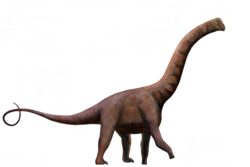Fossil content
Among the following fossils were reported from the formation:
Color key
| Notes Uncertain or tentative taxa are in small text; |
Dinosaurs
Sauropods
| Sauropods of the Pab Formation | ||||||
|---|---|---|---|---|---|---|
| Genus | Species | Location | Stratigraphic position | Material | Notes | Images |
| Isisaurus [3] | I. colberti | Vitakri Member | Maastrichtian | Braincase, possible Ulna | A lithostrotian titanosaur |  |
| Jainosaurus ? [3] | J. septentrionalis | Vitakri Member | Maastrichtian | Humerus | A colossosaurian titanosaur |  |
| Lithostrotia Indet. | Indeterminate | Vitakri Member | Maastrichtian | A lithostrotian titanosaur; informally known as "Khetranisaurus barkhani". | ||
| Lithostrotia Indet. | Indeterminate | Vitakri Member | Maastrichtian | A lithostrotian titanosaur; informally known as "Maojandino alami". | ||
| Lithostrotia Indet. | Indeterminate | Vitakri Member | Maastrichtian | A lithostrotian titanosaur; informally known as "Pakisaurus balochistani". | ||
| Lithostrotia Indet. | Indeterminate | Vitakri Member | Maastrichtian | A lithostrotian titanosaur; informally known as "Sulaimanisaurus gingerichi". | ||
| Opisthocoelicaudiinae Indet. | Indeterminate | Vitakri Member | Maastrichtian | A opisthocoelicaudiine saltasaurid; informally known as "Balochisaurus malkani". | ||
| Saltasaurinae Indet. | Indeterminate | Vitakri Member | Maastrichtian | A saltasaurine saltasaurid; informally known as "Marisaurus jeffi". | ||
| Titanosauria Indet. | Indetrminate | Vitakri Member | Maastrichtian | A titanosaurian sauropod; Informally known as "Gspsasaurus pakistani". | ||
| Titanosauria Indet. | Indeterminate | Vitakri Member | Maastrichtian | A titanosauria titanosaur; informally known as "Imrankhanhero zilefatmi". | ||
| Titanosauria Indet. | Indeteminate | Vitakri Member | Maastrichtian | A titanosaurian sauropod; informally known as "Nicksaurus razashahi" | ||
| Titanosauria Indet. | Indeterminate | Vitakrid Member | Maastrichtian | A titanosaurian sauropod; informally known as "Qaikshaheen masoomniazi". | ||
| Titanosauria Indet. | Indeterminate | Vitakrid Member | Maastrichtian | A titanosaurian sauropod; informally known as "Saraikimasoom vitakri". | ||
Theropods
| Theropods of the Pab Formation | ||||||
|---|---|---|---|---|---|---|
| Genus | Species | Location | Stratigraphic position | Material | Notes | Images |
| Abelisauridae Indet. | Indeterminate | Vitakri Member | Maastrichtian | A abelisaurid theropod; informally as "Shansaraiki insafi". | ||
| Enantiornithes Indet. | Indeterminate | Vitakri Member | Maastrichtian | A enantiornithean bird | ||
| Majungasaurinae Indet. | Indeterminate | Vitakri Member | Maastrichtian | A majungasaurine abelisaurid; informally known as "Vitakridrinda sulaimani". | ||
| Noasauridae Indet. | Indeterminate | Vitakri Member | Maastrichtian | A noasaurid theropod; informally known as "Vitakrisaurus saraiki". | ||
Pterosaurs
| Pterosaurs of the Pab Formation | ||||||
|---|---|---|---|---|---|---|
| Genus | Species | Location | Stratigraphic position | Material | Notes | Images |
Crocodylomorphs
| Crocodylomorphs of the Pab Formation | ||||||
|---|---|---|---|---|---|---|
| Genus | Species | Location | Stratigraphic position | Material | Notes | Images |
| Pabwehshi [4] | P. pakistanensis | Vitakri Member | Maastrichtian | Skull elements | A baurusuchine baurusuchid | |
| Dyrosauridae Indet. | Indeterminate | Vitakri Member | Maastrichtian | A dyrosaurid tethysuchian; informally known as "Sulaimanisuchus kinwai". | ||
| Mahajangasuchidae Indet. | Indeterminate | Vitakri Member | Maastrichtian | A mahaangasuchid notosuchian; informally known as "Induszalim bala". | ||
| Notosuchia Indet. | Indeterminate | Vitakri Member | Maastrichtian | A notosuchian metasuchian; informally known as "Khuzdarcroco zahri". | ||
Squamates
| Squamates of the Pab Formation | ||||||
|---|---|---|---|---|---|---|
| Genus | Species | Location | Stratigraphic position | Material | Notes | Images |
| Madtsoiidae Indet. | Indeterminate | Vitakri Member | Maastrichtian | A madtsoiid snake; informaly known as "Wadanaang kohsulaimani". | ||
Mammals
| Mammals of the Pab Formation | ||||||
|---|---|---|---|---|---|---|
| Genus | Species | Location | Stratigraphic position | Material | Notes | Images |
Fish
| Fishes of the Pab Formation | ||||||
|---|---|---|---|---|---|---|
| Genus | Species | Location | Stratigraphic position | Material | Notes | Images |